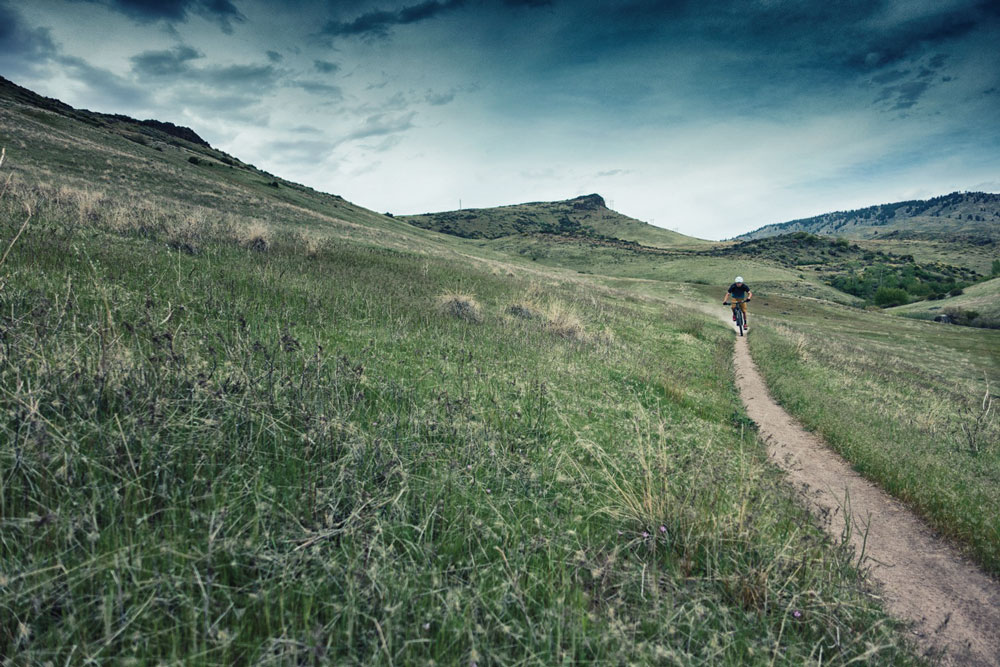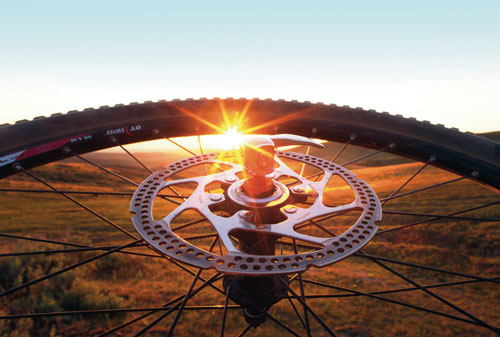This instant, you can virtually ride the Boise Foothills and even download routes to your phone. Boiseans know the better option is to take a screen time break, check the weather, and just head out on the bike.
Get lost. Learn something new about the ever-more connected trails that community volunteers, generous donors and land managers have built over the past quarter century.
Just a few pedal strokes from the front porch, the motel and the downtown office, the view beckons, especially the panorama from the Boise Airport where many will arrive, perhaps as New Belgium Brewing Tour de Fat groupies. Boise’s participation in the pedal-powered pub-crawl breaks records every year and is the most popular stop on the urban tour. It’s the vertiginous promise of more athletic and less boozy rides into the alpine. Last year the 10,000-rider-strong Boise tour stop raised $70,000, locally, with donations going to local nonprofits, the Southwest Idaho Mountain Biking Association, Treasure Valley Cycling Alliance and the Boise Bike Project, all promoters of pedal power over mechanized steam.
“Those of us who love the Boise Foothills trails think it’s one of the best places to ride in the world,” offered Steve Stuebner, one of Idaho’s preeminent thinkers and writers about Idaho’s wild side of sport. Stuebner rejoiced when IMBA dubbed the area, including the Ada/Eagle Bike Park, a Gold Level Ride Center last year. “I thought that was a cool validation of what makes Boise so great. Number one, it’s that Boise is so accessible to Foothills trails. Number two, there’s about 200 miles of trails from the top of Bogus Basin to the Boise River and lots of those ridge trails have been connected. In 2001, the first levy that raised $10 million to purchase land and provide easements through private land really sent a message that the community was serious about protecting the resource.”
In 2017 the city will begin to receive funds from a second $10 million open space levy voters approved by an even wider margin in 2015.
“Over the last year we have been working with the public on the latest 10-year management plan,” said Sarah Arkle, the city’s senior manager for Foothills open space, who explained that cooperation between the community and land managers has created an ethic of stewardship that promotes public, human and horse-powered trail access—much of it distinct from motorized use—dovetailed with protection of habitat and the scenic landscape that is Boise. “There are trails now that connect Bogus Basin to the lower foothills. The levy funds are not specifically related to trail development, but the charter is to acquire open space and implement improvement projects for recreation and to protect native habitat for wildlife.”



Photos By Todd Meier
Long climbs through wild and scenic landscapes—high desert that stretches to the Great Salt Lake, subalpine slopes reminiscent of Great Lakes sand dunes, and alpine cruising through big-tree forest (sometimes snowed in until June)—it’s typically all in view from nearly anywhere in the city. Whether you’re in need of a dose of arrowleaf balsamroot after driving your child to the Jim Hall Foothills Learning Center or even hitching a ride for a warm-up lap on the Around the Mountain Trail at Bogus Basin before bombing back to town, it’s simply a pirate’s bounty, made more bountiful every year with trail additions—50 miles in just the last two years—and better connectivity.
Some of the easements roll through land owned by benefactors such as the Simplot and Grossman families, who’ve helped provide links between drainages like Polecat Gulch Reserve and Stack Rock Reserve, a Grossman effort. Other easements connect popular rides in places like Hulls Gulch and Military Reserve through Simplot land. There are about 10 trailheads close to downtown. An annual fall survey with great participation indicates that ridership and hiking use keeps growing, largely due to the ease of accessibility.
Because of the sensitive nature of the soils, particularly of the lower Foothills trails, the community doesn’t promote big organized events on the system itself (the Tour de Fat takes place in town). The ethic is not to ride if it’s too wet. As the system grows and connectivity improves, use is well managed and there is more variety for all levels of riders, according to the major reviewers of mountain biking trail systems.
Stuebner, whose first guidebook to Foothills rides was published in 1992 with the 5th edition currently sold out, is working on a new book of “quick and dirty” loop rides that will cater to first-time riders in the area—something to whet the appetite.
“Bogus is really stepping it up and running chairlifts on weekends for the first time,” said Stuebner, who’s been riding mountain bikes here since the 1980s. “At Deer Point there are some new trails that are suitable for young kids. Boise has an unprecedented number of biking clubs that are even more social than before. Boise High has a group now in its second year. It goes on and on.”
For the most serious riders a glowing benefit of Boise mountain biking is that some of the lower trails are often open for riding in February.
“Riders from Sun Valley, Pocatello or McCall, where trails are still packed in snow, can come to Boise and enjoy a kick start,” Stuebner said. “It’s a real bonus to get out and rip that early in the season.”
